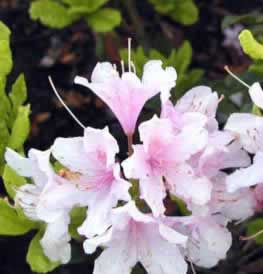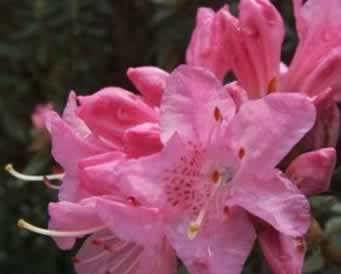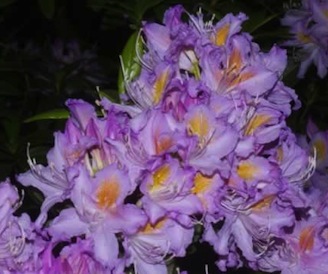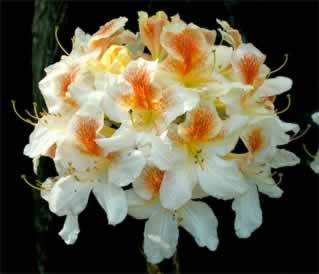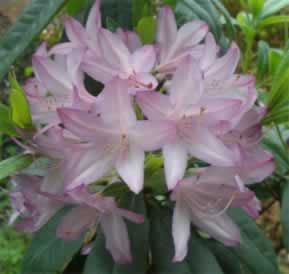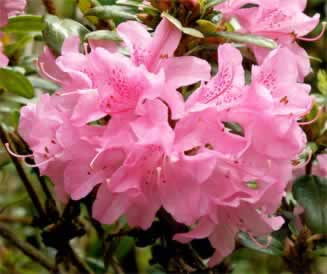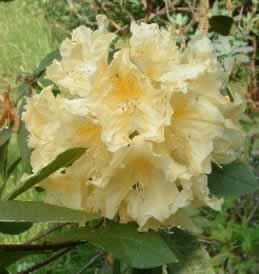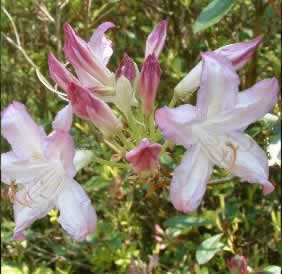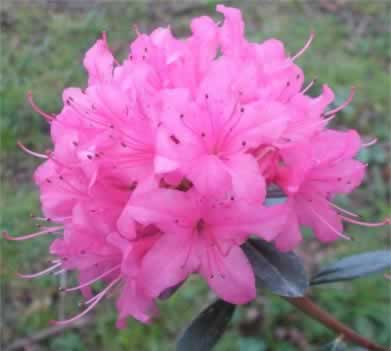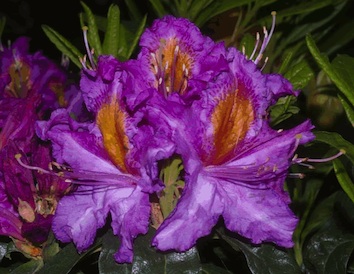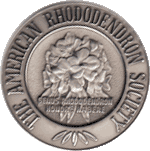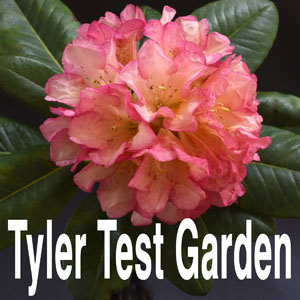
Azaleodendrons
The genus Rhododendron is divided into subgenera, with different subgenera for deciduous azaleas, evergreen azaleas, lepidote rhododendrons and elepidote rhododendrons. Most Rhododendron hybrids are between plants in the same subgenus. Azaleodendrons are hybrids between plants in different subgenera. Since few crosses between different subgenera are successful, there are relatively few Azaleodendrons.
The First Azaleodendrons: The very first known hybrid rhododendron was an Azaleodendron. The name R. azaleoides starts in a French work – Dumont de Courset’s Botaniste Cultivateur, Vol. III (1811). The plant described had come from England, and there is little doubt that it was the hybrid raised at Thompson’s nursery at Mile End, near London, from R. ponticum pollinated by some azalea – possibly R. periclymenoides (nudiflorum). It is figured in Andrews’ Botanical Repository, t. 379 (1804), under the name R. ponticum var. deciduum, though R. azaleoides was apparently the name used for the hybrid by the nursery. At any rate, Sims stated in 1822 that Thompson had four varieties under the name R. azaleoides, one of which had scented flowers. This name has been a source of confusion, since it was used more or less in the same sense as the modern term ‘azaleodendron’ and applied later to other hybrids of this character. Whether the original R. azaleoides is still in cultivation it is impossible to say.
In 1817, the British botanist, poet, and clergyman, Hon. and Rev. William Herbert created Rcv. 'Hybridum' (or Rcv. 'Odoratum), a cross of the azalea R. viscosum and the rhododendron R. maximum. It is a fragrant yellow.
Some claim the first hybrid recorded was another Azaleodendron, a chance hybrid between R. calendulaceum and R. ponticum that occurred in Thompson's Mile End Nursery. By 1819 there was a plant of this in the collection at the Royal Botanic Garden at Edinburgh, listed as R. subdeciduum 'Thompson's Hybrid'.
The Term Azaleodendron: The name ‘Azaleodendron’ was coined by Rodigas in 1892 for hybrids between the Japanese azalea R. japonicum (the Azalea mollis of gardens) and various Hardy Hybrid rhododendrons, raised at Ghent a few years previously. The following year it was taken up by Dr. Masters as a sectional name under Rhododendron. The azaleodendrons, being hybrids between two major subgenus, were given the rank of a separate subgenus – subgen. Azaleodendron (Rodigas) Rehd. In modern classifications, Rehder’s two main groups (Eurhododendron and Anthodendron) are split into two or more subgenera but as it happens, all the known azaleodendrons, with the exception of the Hardijzer group, are of similar parentage to the type of the subgenus Azaleodendron, being crosses between the deciduous azaleas of the subgenera Azalea and elepidote rhododendrons of subgenera Hymenanthes, and therefore constitute a single subgenus, for which the name Azaleodendron continues to be valid. Attention is called to this fact since it is often assumed that the term ‘azaleodendron’ is merely a horticultural coinage of no botanical standing, when in fact it is only invalid when used as a generic name.
According to Fred Galle's book, Azaleas, when W. H. Hardijzer of Boskoop, Holland registered the Hardijzer hybrids between 1958 and 1965, the subgenus Azaleodendron was reserved by scientists for crosses between elepidotes and deciduous azaleas, which were up until then the only known instances of crosses between 'rhododendrons' and azaleas. Hardijzer's crosses were between the lepidote, R. racemosum, and evergreen azaleas. They have been lumped with Azaleodendrons because no other nothosubgenus has ever been created for them. Subgenus is classification term that is used for species. Hybrids are not classified with the same terms. However the term nothosubgenus is used to define a classification similar to subgenus just for hybrids.
In 1830, William Smith, introduced 2 Azaleodendrons. He was gardener to the Earl of Liverpool at Coombe Wood, Kingston on Thames, and later nurseryman at Norbiton. The Azaleodendrons were:
• Rcv. 'Norbitonense Aureum' - ((maximum x ponticum) x molle)
• Rcv. 'Norbitonense Broughtonianum' - ((maximum x ponticum) x molle)
The Next Azaleodendrons: In 1832, J. R. Gowen, who later became Secretary of the Royal Horticultural Society, introduced the Azaleodendron, Rcv. 'Ornatum', a cross of the azalea R. viscosum and the rhododendron R. ponticum.
Paxton of Chandler & Sons Nursery, London, introduced Azaleodendron Rcv. 'Fragrans', R. ponticum x "viscosum", in 1843, and described it as, "A sweet-scented Azaleodendron, fast-growing and compact with trusses of small flowers, pale mauve with centers lighter to white." Recent DNA testing of Rcvs. 'Fragrans', 'Fragrans Affinity', and 'Fragrant Affinity' verified that all three are crosses of R. ponticum and probably "viscosum", but that the three hybrids are distinct, and not the same clones. The report leads to speculation that the "viscosum" in the three cases were probably natural hybrids of viscosum since these are common in the wild and difficult to identify. Furthermore, it was concluded that the "viscosum" in the three cases were different viscosum hybrids. However, the tests concluded that hybrids Rcvs. 'Fragrans', 'Fragrans Affinity', and 'Fragrant Affinity' were definitely the results of crosses of evergreen rhododendrons of subgenus Hymenanthes and deciduous azaleas of subgenus Pentanthera. All three are semi-evergreen and closely resemble the description provided by Salley and Greer (1986) of 'Fragrans.'
Considering how many azaleodendrons were raised in the nineteenth century, Lionel de Rothschild’s failure in breeding them is interesting. For two years running he crossed any hybrid rhododendron he had in flower with four different types of azalea, making the crosses both ways – fifty or sixty crosses each year all told. From these he got one pod of seed and raised three seedlings, which had not flowered at the time he wrote (Y.B. Rhod. Ass. J934, pp. 113-14). There is no further record of these, so presumably they were worthless.
August Kehr published a paper in 1977 stating that deciduous azaleas and elepidote rhododendrons would hybridize and some lepidote rhododendron flowers would hybridize with evergreen azalea pollen, but most other possible crosses were long shots. He also noted that usually Azaleodendrons are completely sterile.
A group from North Carolina State reported on 2005 on using Azaleodendrons in breeding fragrant rhododendrons:
"It is possible to bring excellent fragrance from deciduous azaleas into evergreen rhododendron through inter sub-generic hybridization resulting in novel “Azaleodendrons”. Hybrid sterility is an issue, but development of tetraploid Azaleodendrons can restore fertility. We have developed tetraploid Azaleodendrons with excellent fragrance, semi-evergreen foliage, and moderate fertility. These plants will serve as a foundation for backcrossing to diploid and tetraploid, evergreen rhododendrons."
Kenneth Cox observed in his book, Rhododendrons & Azaleas - A Colour Guide, that Azaleodendrons are crosses between elepidote rhododendrons and deciduous azaleas except the Hardijzer's, which are crosses of the lepidote, R. racemosum, with evergreen azaleas. He also points out that Azaleodendrons are less disease resistant and prone to more problems than most other hybrid rhododendrons and azaleas.
Other intersubgenus hybrids:
[Return to Top]
Hardijzer Hybrids
When W. H. Hardijzer of Boskoop, Holland registered the Hardijzer hybrids between 1958 and 1965, the term Azaleodendron was reserved by scientists for crosses between elepidotes and deciduous azaleas, which were the only known instances of crosses between rhododendrons and azaleas. Hardijzer's crosses were between the lepidote, R. racemosum, and Kurume evergreen azaleas. They have been lumped with the Azaleodendrons because there is no other subgenus created for them. According to Fred Galle's book, Azaleas, the Hardijzer Azaleodendrons include:
• Rcv. 'Hardijzer Beauty' – R. racemosum x Kurume Hybrid, 1965. Strong purplish pink, lightly flushed purplish red, with darker spotting.
• Rcv. 'Lillian Harvey' – R. racemosum x Kurume Hybrid, 1965. Vivid reddish purple.
• Rcv. 'Maritime' –R. racemosum x Kurume Hybrid, 1965. Deep purplish pink with darker spots.
• Rcv. 'Ria Hardijzer' – R. racemosum x 'Hinode Giri', 1965. Vivid purplish red with faint spots in blotch.
[Return to Top]
Induced Apogamy or Self-Pollination
Induced apogamy has been one problem observed in attempts to cross rhododendrons and azaleas. When one is making wide crosses with unlikely parents sometimes one gets seedlings that bear absolutely no resemblance to the pollen parent but are identical to the seed parent. This is explained by Clement Gray Bowers in his book Rhododendron and Azaleas.
"In rhododendrons there are occasional instances of induced apogamy, where pollination seems to stimulate the production of apomictic seed without, however, reaching the point of gametic fusion. I observed an instance where both hybrid and apomictic seedlings were simultaneously produced from one female parent. Apomixis is sometimes observed in cases of wide crosses."
This subject is controversial. Some, including August Kehr (in Galle's book Azaleas) and George Ring, claim that it is not apogamy, but rather self-pollination. Unfortunately apogamy leads to sterile crosses, but so can self-pollination. George Ring claims that if a flower is properly emasculated that apogamy is not observed. Hence, it is not apogamy, but self-pollination.
[Return to Top]
Examples of Azaleodendrons
[Return to Top]
Azaleodendrons
Rcv. 'Azaleoides' – R. ponticum x R. periclymenoides by Thompson around 1820 at Mile End Nursery in London. The fragrant flowers are a pale lilac with a yellow center. This name has been a source of confusion, since it was used more or less in the same sense as the modern term ‘azaleodendron’ and applied later to other hybrids of this character.
Rcv. ''Broughtonii Aureum' – (R. maximum x R. ponticum) x R. molle by W. Smith of Norbiton around 1830. Evergreen shrub with round trusses of yellow flowers and leaves with a very glaucous underside and which turn bronzy in winter. The height is 4' in 10 years. It is hardy to -5F.
Rcv. 'Fragrans' –R. ponticum x R. viscosum by Paxton of Chandler & Sons Nursery in London in 1843. Clusters of 12-20 small very fragrant flowers, white with lilac flush, on a small bush with leaves that are nearly evergreen. Flowers late. Height: 4-5' after 10 years This plants flowers in the North Hemisphere around Late May-Early July. It is hardy to -5F.
Rcv. 'Fragrans Affinity' –R. ponticum x viscosum, was introduced by Harold Greer. It has better foliage than most azaleodendrons. The flowers are a showy orchid-blue. The plant is dense and strong. Height is 5' in 10 years. It is hardy to -10F. Photo courtesy of Harold Greer. [Return to List]
More Azaleodendrons
|
Rcv. Glory of
Littleworth |
Rcv. 'Glory of Littleworth' – was raised by Henry Mangles. A stunning plant with fragrant funnel-shaped flowers, opening cream, becoming milky white with conspicuous coppery orange blotch. Flowering in May, this is a superb semi-evergreen azalea-like shrub. It can look a little untidy in the winter, but the flowers are wonderful. Height 5' in 10 years. -5F.
Rcv. 'Gowenianum' – hybrid between a (catawbiense x ponticum) hybrid and a deciduous azalea dates from before 1825. Strongly scented light purple star shaped flowers appear in early June. The leaves are usually evergreen during most winters. Height 4' in 10 years. -5F.
Rcv. 'Hardijzer Beauty' – R. racemosum x (Kurume Azalea) by W. H. Hardijzer, The Nurseries, Boskoop, Holland, before 1958. A dwarf Azaleodendron reaching 3' in 10 years, vigorous, upright dense habit. Leaves are retained 2-3 years and may turn purplish-green in winter. Flowers small with strong purplish-pink and lightly flushed deep purplish-pink, purplish-red spotting in throat. –5F, early-mid season. Sun tolerant. It is an excellent choice for a small bed or long, low border.
Rcv. 'Martha Isaacson' – slightly fragrant white flowers that are striped pink. It is vigorous. Flowering in May, it has unusual evergreen foliage that is tinged deep maroon. Height 5' in 10 years. +5F.
[Return to List]
More Azaleodendrons
|
Rcv. Norbiton-
ense Aureum |
Rcv. 'Norbitonense Aureum' – (R. maximum x R. ponticum) x R. molle. Evergreen shrub with round trusses of yellow flowers and leaves with a very glaucous underside and which turn bronzy in winter. Height 5' in 10 years. +5F.
Rcv. 'Odoratum' – R. ponticum x R. periclymenoides. Glossy, small leaves, evergreen and slightly variegated, numerous trusses of very fragrant blush flowers richly edged with lilac. Late flowering time. Height 4' after 10 years. This old Azaleodendron should not be overlooked in today’s gardens. Heat tolerant.
Rcv. 'Ria Hardijzer' – R. racemosum x 'Hinodegiri' by W. H. Hardijzer, The Nurseries, Boskoop, Holland, before 1958.. Lovely small vivid purplish red flowers with faint spots. This is an unusual hybrid between a rhododendron and an evergreen azalea. It is hardy, but dislikes too much heat. Height 2' in 10 years. -5F.
Rcv. 'Valley Sunrise' – by Robert Ticknor. The flowers have a orange blotch against an orchid background. The plant grows to 4' in 10 years. It is hardy to -5F. Photo is courtesy of Harold Greer. [Return to List]
How To Grow Azaleodendrons
Plants bearing the code designation H-1 survive to -25°, H-2 to -15°, H-3 to -5°, H-4 to 5°, H-5 to 15°, H-6 to 25° and H-7 to 32°.
Azaleodendrons grow best in partial shade, since full sunlight tends to bleach the flowers. They need an acid soil with a pH of 5.0 to 6.0, well mulched with organic material. Mix garden loam with equal parts of coarse sand and ground bark or oak leaves before planting. Soil around the rhododendrons' shallow roots must be kept cool and moist but well drained. All except leather-leaf varieties transplant well in the spring, or in the fall if mild winter weather does not damage the shallow-rooted plants. Fertilize once a year after the plant blooms with a mixture of 5-10-5 and cottonseed meal. Prune rhododendrons after the flowers have faded to induce new growth. Most Azaleodendrons are propagated from cuttings rooted in sand or a mixture of sand and peat, or by grafting.
[Return to Top]
Directory of Contents for Henning's Rhododendron & Azalea Pages
•• Providing Information about the Genus Rhododendron since 1996
••
Articles Published by the American Rhododendron Society
Return to Top

Last Updated:
July 6, 2020
|


